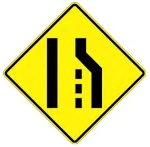 Recently I was on Highway 97 proceeding north and about to enter Westbank when a car exiting the connector highway, 97C, came abreast of me on my right. We were in a “dead heat,” at the merge, with neither vehicle as much as a car’s length ahead of the other.
Recently I was on Highway 97 proceeding north and about to enter Westbank when a car exiting the connector highway, 97C, came abreast of me on my right. We were in a “dead heat,” at the merge, with neither vehicle as much as a car’s length ahead of the other.
I Have the Right of Way to Merge

I felt that I had the right of way and continued at the same speed. The other car merged after me, repeatedly sounding her horn. Then she came abreast, rolled down her window, and motioned that I do the same. The driver was obviously extremely irritated and yelled to me that merging traffic has the right of way.
Merging Traffic Does Not Have Right of Way
Now I have been a licensed driver in several States and Provinces plus Germany in the past sixty years, and the only place I’ve been where tributary lanes entering a highway always have the right of way was in Texas. I was taken aback by my encounter with the irate motorist and wondered whether she was a Texan, or even--God forbid--could I be wrong about the BC traffic regulations?
What I've Learned
Reading comments in this and other forums, I have gleaned the following information:
When joining an adjacent lane of traffic, a Yield sign governing your lane means just that: yield to the oncoming traffic in the other lane. When being joined by a tributary lane of traffic (i.e., a lane-ending situation), a Merge sign governing your (continuing) lane means that traffic in both lanes should yield alternately.
When joining an adjacent lane of traffic marked with a sign or signs containing the lane-ending symbol, the continuing lane has right of way over the ending lane. In the above-mentioned situation, there is a Lane-Ending sign placed next to the continuing lane (Hwy 97) and a Merge sign placed next to the ending lane (Hwy 97C). Two cars approach this point of confluence at the same time.
Who, would you say, has the right of way?
You've Covered It
It looks to me like you have the situations fully described. Right of way simply says who is supposed to be first. Having it does not mean that you should insist on it or are exempt from being involved in a crash.
Defensive Driving
The only comment that I might add is that you made a choice that a defensive driver probably would not have, choosing to remain side by side with another vehicle and not adjusting your position to "leave yourself an out" if something happened. Even when you have the right of way, self preservation takes a higher priority. If that means surrendering your right of way for improved safety it's a worthwhile trade.
Share This Article
- Log in to post comments
